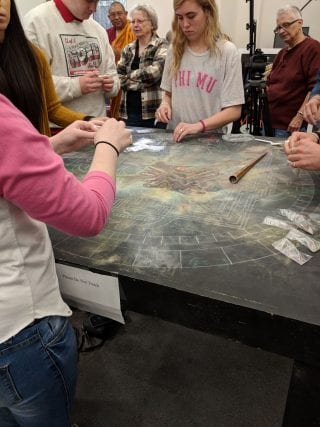Teaching Compassion Through Cultural Experiences
 Thupten Dorjee grew up in a Tibetan refugee settlement in India, sometimes receiving barely enough food to get by. One day, an elderly monk from Drepung Loseling Monastery in the south of India shared his meager portion with the boy.
Thupten Dorjee grew up in a Tibetan refugee settlement in India, sometimes receiving barely enough food to get by. One day, an elderly monk from Drepung Loseling Monastery in the south of India shared his meager portion with the boy.
That small act of kindness was enough to spark Dorjee’s interest. Dorjee decided to become a Tibetan Buddhist monk himself, dedicating his life to the cause of compassion.
Today, Dorjee teaches in the J. William Fulbright College of Arts and Sciences, bringing his unique perspective to students in classes such as The Literature of Non-Violence, Mindfulness and Mental Health and Tibetan Buddhist Philosophy and Culture.
He started teaching at the U of A in 2006, and quickly became a favorite instructor, receiving the Outstanding Faculty Award in 2008 – a tribute to the impact his teaching has had on the lives of his students.
 His students even call him Geshe-la, a term of respect for the monk’s standing as a lharampa geshe, the highest academic title conferred by the Gelug monastic university system of which he is a part.
His students even call him Geshe-la, a term of respect for the monk’s standing as a lharampa geshe, the highest academic title conferred by the Gelug monastic university system of which he is a part.
As a continuation of sharing his Tibetan culture, Dorjee also constructs sand mandalas in Northwest Arkansas and surrounding areas. Dorjee said the traditional, two-dimensional structure acts as both a map and an instruction manual on how to bring about positive transformations in our lives.
Since moving to the United States, Dorjee has constructed 12 mandalas. His most recent mandala, the healing sand mandala and the smallest one he has made here so far, was constructed in the Helen Robson Walton Reading Room in the Mullins Library.
Tibetan sand mandalas are representative of the universe, Dorjee said, using specific geometries and color palettes.
“Every universe is built on one grain of sand, just like this mandala,” he said. The completed structure represents all of the different disciplines in the University, in one object, Dorjee said.
 As part of their studies, the monks memorize the dimensions of the mandalas. Each mandala is then created from memory, using only a variety of colored sand and a special tool called a chap-kur.
As part of their studies, the monks memorize the dimensions of the mandalas. Each mandala is then created from memory, using only a variety of colored sand and a special tool called a chap-kur.
The healing sand mandala was constructed over the course of a week by invited guest lecturer Geshe Yeshi Topgyal and was destroyed this fall during the closing ceremony Saturday, Nov. 17. The act of destroying the mandala symbolizes that nothing lasts forever, therefore, we should not become attached to anything.
“This is not about religion, it is academic. It is what we can achieve if we have the right mindset,” Dorjee said during the closing ceremony. “I truly believe we can change the world with our common sense, our love, compassion and support. This is a starting point for your lives to turn around in the right direction.”
Simply by being in the presence of the healing sand mandala, Dorjee said observers will reap the positive energy it emits.
 “People come with bad energy, but then they receive the blessings and become sensitive and emotional,” Dorjee said. “It brings healing, harmony and diversity.”
“People come with bad energy, but then they receive the blessings and become sensitive and emotional,” Dorjee said. “It brings healing, harmony and diversity.”
Dorjee also leads several local meditation groups, including one at the Northwest Arkansas Community Correction Center, and routinely lectures at regional schools, colleges and community groups.
Dorjee considers Fayetteville his home – at least as much of a home as a monk committed to the Buddhist principle of non-attachment can have.
“The Buddha taught that we must have satisfaction with what we have,” Dorjee said. “In the end, what matters is service to other human beings. There’s nothing to be attached to, beyond that.”
Bettina Lehovec
Staff Writer, University Relations
479-575-7422 // blehovec@uark.edu
Olivia Chivers
Communications Project Manager
J. William Fulbright College of Arts and Sciences
479-575-2130 // ochivers@uark.edu

